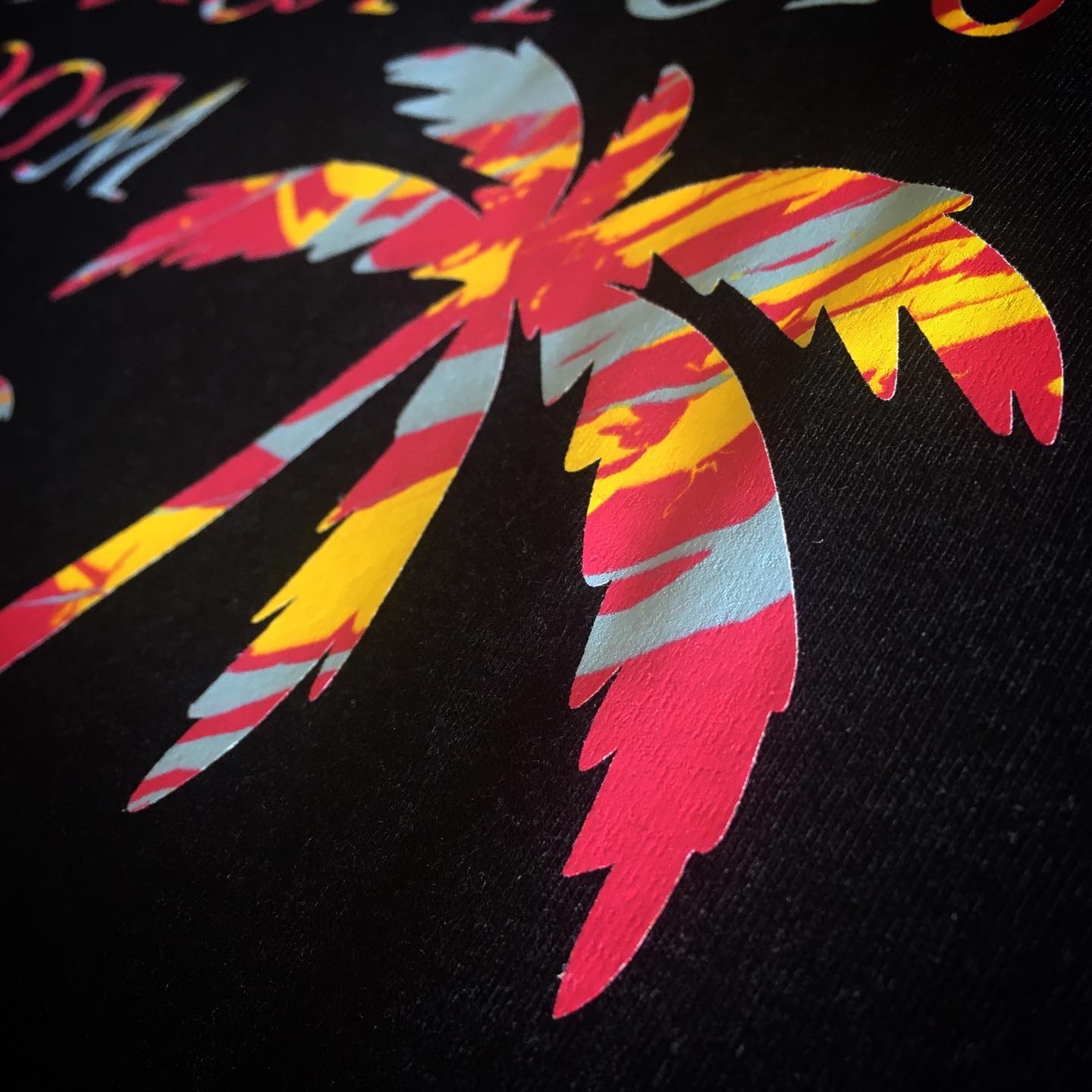High-Volume T-Shirt Printing for Schools and Organizations
Display Printing Uncovered: Whatever You Need to Find Out About T-Shirt and Garment Printing Methods
Display printing is an interesting approach that integrates art with technique, providing countless opportunities for creative thinking. Ready to discover the vital elements that make display publishing an art kind?
The Basics of Display Printing: How It Works
When you plunge right into screen printing, you'll find it's both an art and a scientific research. At its core, screen printing entails developing a stencil, or display, that allows ink to pass with just in specific locations.
Setting the screen over the material, after that use a squeegee to push ink through the screen onto the garment. Each action is crucial, and understanding them will boost your display printing abilities, changing easy garments right into distinct, expressive items.
Kinds of Display Printing Methods
Once you comprehend the fundamentals of display printing, it's time to check out the numerous strategies that can elevate your designs. One preferred approach is conventional screen printing, where ink is pushed via a stenciled display.
If you're intending for fine details, take into consideration discharge printing. This strategy removes dye from the material, leaving a soft, classic appearance. One more choice is plastisol printing, recognized for its resilience and brilliant shades, making it a favorite for numerous brands. Experiment with halftone printing to create gradient effects and detailed designs. Each technique has its special beauty, so don't wait to attempt them out to locate what suits your style best!
Important Tools for Display Printing
To attain magnificent lead to screen printing, having the right devices is essential. First, you'll need a durable screen printing framework, which holds the mesh that moves your layout onto the garment. Next, spend in premium mops; these are essential for applying ink uniformly across the screen. You'll also require an excellent direct exposure device to produce your screens, as well as a washout booth for cleaning them after usage. A trusted warm source, like a conveyor clothes dryer or heat press, is vital for healing your prints to ensure longevity. Don't fail to remember an appropriate workspace, geared up with tables and storage space for your materials. Finally, safety equipment, such as masks and gloves, will maintain you risk-free from chemicals and inks. With the right tools, you'll be well on your way to generating professional-quality prints.
Choosing the Right Inks and Materials
When picking inks and materials for display printing, you require to take into consideration the kind of ink that functions finest for your task. Consider textile compatibility to ensure your styles look last and terrific lengthy. Check out eco-friendly ink choices to make your printing procedure extra lasting.
Sorts Of Screen Inks
Picking the appropriate display ink is necessary for accomplishing vibrant, resilient prints that meet your task's demands. There are a number of kinds of screen inks to take a look at. Plastisol ink is preferred for its convenience and simplicity of usage, giving exceptional shade opacity on dark textiles. Water-based ink, on the other hand, offers a softer feeling and is environment-friendly, making it excellent for those looking to lessen their environmental impact. Discharge inks remove dye from the fabric, causing a soft, classic appearance yet call for particular handling. Specialized inks, such as metallic or glow-in-the-dark, can add special impacts to your styles. Examine your task requirements and pick the ink that aligns ideal with your wanted outcome.

Fabric Compatibility Factors To Consider
Recognizing material compatibility is essential for accomplishing top quality screen prints, especially because different products react uniquely to numerous inks. Always examine your inks on sample material to assure they adhere effectively and keep shade integrity. In addition, maintain in mind that material weight and appearance can influence the final end result, so selecting the appropriate ink and material combo is important for your job's success.
Eco-Friendly Ink Options
Environmentally friendly inks are ending up being a prominent option for display printers who wish to lessen their ecological influence while maintaining quality. When selecting inks, think about water-based inks, which are less unsafe and simpler to clean up compared to conventional solvents. These inks bond well with materials, delivering vivid outcomes without hazardous chemicals. You may additionally discover eco-solvent inks that utilize less volatile organic substances (VOCs), making them a more secure option for both your wellness and the earth.
In addition, search for inks made from renewable resources, such as soy or vegetable-based alternatives. By selecting the best inks and products, you'll not only create stunning designs but likewise contribute to a much more sustainable printing process. Make the switch, and your prints will certainly mirror your dedication to the setting!
Preparing Your Style for Screen Printing

Submit Format Requirements
To assure your design looks sharp and vivid on textile, you'll require to pay attention to file layout needs for screen printing. Start with vector documents like AI or EPS, as they can be scaled without shedding quality. If you utilize raster images, select high-resolution files, such as TIFF or PNG, ideally at 300 DPI. Avoid using JPEGs, as they can shed clarity when resized. Additionally, make certain your layout has a clear background to protect against unwanted white edges on your prints. Finally, keep shade settings in mind; CMYK is conventional for screen printing, so convert your RGB creates appropriately. By following these guidelines, you'll set your artwork up for a successful print.
Shade Separation Strategies
Color splitting up is an important action in preparing your style for display printing, and mastering it can significantly improve your print high quality. You'll need to damage your style right into private colors, as each color calls for a separate screen during printing. This precision not just assures exact shade depiction however also enhances the printing procedure.
Resolution and Dimension
Achieving the best cause display printing starts with ensuring your layout has the appropriate resolution and size. Preferably, your artwork needs to go to the very least 300 DPI (dots per inch) for sharp, clear prints. Your final item might look pixelated and unprofessional. if you use reduced resolution.
When it comes to size, consider the measurements of your print location. Layout your artwork to match the final print size, preferably producing it in the actual measurements you'll additional resources be publishing. In this manner, you'll stay clear of any kind of unforeseen scaling concerns.
Constantly check your style in both vector and raster formats. Vector graphics can be scaled without shedding quality, making them ideal click resources for screen printing. Preparing properly will guarantee your layout looks remarkable on every garment!
Step-by-Step Screen Printing Process
Screen printing is a vibrant process that permits you to develop lively styles on different surface areas. To begin, you'll need a screen, solution, and your picked ink. First, prepare your display by cleaning it thoroughly. Next off, use the solution uniformly and allow it completely dry in a dark area. When dry, expose your screen to light with your design positioned on it, which will solidify the emulsion where the light hits, creating a stencil - screen printing kit.
After washing out the unexposed emulsion, your display prepares. Establish it up on your printing surface and align your garment under it. Pour ink onto the display and use a squeegee to press the ink with the pattern onto the material. Lift the screen very carefully and allow the print dry. Finally, treat the ink making use of warm to guarantee resilience. That's it! You have actually effectively screen printed your layout.
Tips for Successful Screen Printing Projects
While you're diving into your screen printing tasks, keep in mind that preparation is vital to success. Beginning by collecting all your materials-- inks, screens, garments, and mops. A tidy work area aids protect against unwanted mistakes, so clean up prior to you start.
Next, confirm your artwork is high-resolution and properly sized for your garment. Examine your screen for appropriate exposure and clean it thoroughly to prevent smudges. When mixing your inks, comply with the maker's guidelines to attain the right news consistency.
Throughout printing, use even stress with your squeegee for regular outcomes. Don't rush; take your time to validate each print meets your standards. After printing, allow your garments dry completely prior to managing or packaging them.
Lastly, constantly maintain a sample of your help future referral. By doing this, you can assess your development and boost your methods with time. Satisfied printing!

Regularly Asked Inquiries
The length of time Does It Require To Establish a Screen Printing Work?
Setting up a display printing task generally takes around 30 mins to an hour. You'll prepare the screens, mix inks, and readjust journalism. The moment varies based on intricacy and experience, so stay arranged!
Can I Publish on Various Textile Enters Making Use Of the Same Technique?
Yes, you can print on different fabric kinds utilizing the same method, yet you'll need to readjust your inks and settings. Some fabrics take in ink in a different way, so trying out assurances the most effective results for each and every product.
What Prevail Mistakes to Stay Clear Of in Screen Printing?
When display printing, stay clear of usual mistakes like utilizing the wrong ink, overlooking correct direct exposure times, or missing pre-press checks. Constantly check your configuration and preserve tidy displays to guarantee high quality results each time.
How Can I Appropriately Tidy and Preserve My Screen Printing Equipment?
To correctly clean and preserve your screen printing equipment, you must regularly wash displays with appropriate solvents, inspect mops for wear, and assure all devices are saved dry and dust-free. Uniformity avoids pricey repair work and boosts performance.
Is Screen Printing Eco-friendly Contrasted to Various Other Methods?
Screen printing can be a lot more eco pleasant than various other approaches, particularly if you make use of eco-conscious products and water-based inks. By selecting sustainable materials and methods, you lower waste and decrease your effect on the earth.
Screen Printing Uncovered: Whatever You Required to Know Regarding Tee Shirt and Garment Printing Techniques
At its core, screen printing entails developing a stencil, or display, that permits ink to pass with only in particular areas. Setting the screen over the fabric, after that utilize a squeegee to push ink through the screen onto the garment. One prominent approach is conventional display printing, where ink is pressed via a stenciled display.When picking inks and materials for screen printing, you need to take into account the kind of ink that works ideal for your project.